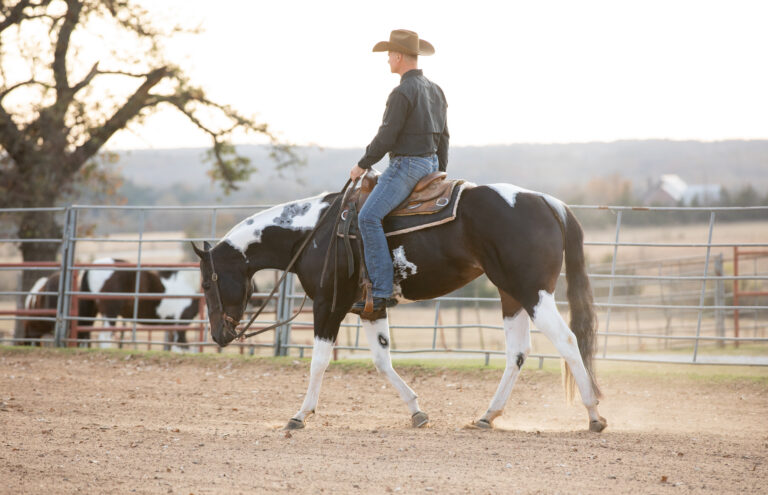
Hay is a staple in the horse’s diet. Extensive research has shown the benefits of consuming stemmy forage. Those benefits range from aiding in normal tooth wear to buffering stomach acid to keeping horses content through nibbling.
Experts recommend that forage comprise at least 50% of a horse’s daily ration. Depending on the client’s management style, that could be a mix of grazing and hay. Most horse owners heavily rely on hay to meet their horses’ daily energy requirements.
“Hay in the program can help with digestive health as chewing of long-stem hay results in more saliva production and greater buffering capacity in the stomach,” said Bob Coleman, PhD, PAS, a University of Kentucky associate professor and equine extension specialist.
Many horses, especially easy keepers, can fulfill most nutritional requirements from grazing and hay. So, when clients feed good-quality hay, they can potentially reduce their overall feed costs.
However, performance horses, lactating mares, and hard keepers might require additional calories from a formulated feed to maintain a healthy weight.
“Our modern hay is almost the perfect food, but it’s not 100% nutritionally balanced,” said Kathleen Crandell, PhD, an equine nutritionist at Kentucky Equine Research. She said if owners are soaking hay to reduce sugars, that process also “takes more nutrients out of it, so a vitamin and mineral supplement is needed to make up for those lacking in the hay. And if the hay doesn’t have enough energy to support the horse’s weight, then a feed may be necessary.”
Four Common Hay Questions

Horse owners often look to their veterinarians for advice on what and how to feed hay to their horses. Crandell and Coleman shared four common questions you might hear from clients and offered their advice for responding to the inquiries.
1) How much hay should I be feeding?
It depends. The horse’s age, breed, medical status and performance level all factor into how much hay a horse needs, explained Coleman. As a general rule, Crandell said horses need at least 1.5% of their body weight in hay daily. Performance horses, hard keepers, growing horses and lactating mares could consume as much as 3% to 5% of their body weight.
Coleman cautioned about feeding strictly by a percentage of body weight without knowing the digestible energy (DE). DE is similar to a calorie count. On average, most hays range between 0.75-1.0 Mcal per pound.
Therefore, if a 1,100-pound horse requires 16.7 Mcals to maintain his weight and the hay DE is 0.87 Mcals/pound, the horse needs 19 pounds of hay daily.
“That is about 1.73% of the horse’s body weight,” Coleman said. “If we were to use 2.5% of the horse’s weight, that would be 27.5 pounds of hay, giving 24 Mcals of DE. That equals 143% of the horse’s requirements. So, the horse would be gaining weight.”
Crandell said that if a horse has higher nutritional needs than what the hay provides, concentrated feeds or grains can top off the calories.
2) What is the best way to feed my horse his hay?
Feeding hay on the ground, from a rack or net, in a feeder, or under a hut are all common methods, and there is some debate about which method is “best.” Each has its pros and cons, its fans and detractors. However, several recent research studies share new insights into commonly used approaches to feeding hay.
The January 2023 Frontiers in Veterinary Science published the article Which animal-to-feeding-place ratio at time-controlled hay racks is animal appropriate? Preliminary analysis of stress responses of horses.1 The researchers examined the dynamics of group feeding horses hay, Crandell explained. The study used something similar to a hay hut, popular for reducing waste, to explore the impact of forcing horses to eat side-by-side versus being spread out. While the horses were eating, the team measured the horse’s hormone levels.
“What they found was interesting. Horses eat more when spaced out rather than being forced to eat next to each other,” Crandell said. “And their stress level was almost zero when they had at least twice as much room between their feeding stations than if they were side-by-side. So, when we force horses to eat close to each other, we’re stressing them out and don’t even realize it.”
Two studies looked at hay nets and a correlation between neck strain. A preliminary study on the effects of head and neck position during feeding on the alignment of the cervical vertebrae in horses2 focused on hay feeding position and the horse’s posture and neck strain. Horses were fed at three different heights—on the ground, from a low-hanging net so the bottom of the net was at knee height, and with the bottom of the net at elbow height.
“When the hay was on the ground or at a medium height, it didn’t significantly change the horse’s posture. But when the bottom of the net was elbow height, it affected their neck and back posture causing undue strain,” Crandell said.
The other study, Posture and Pull Pressure by Horses When Eating Hay or Haylage from a Hay Net Hung at Various Positions,3 looked at hay net hole size. Again, the results revealed that smaller holes caused greater strain on the horse’s neck while pulling hay out of the smaller opening.
“We’re all really eager to go to small hole hay nets because it slows horses down,” Crandell said. “But we might be affecting how they are chewing and straining their neck and back posture. I think we still have a lot to learn about hay nets.”
3. Can I feed my horse straw?
Chances are it’s unlikely a client will ask, “Can I feed straw to my horse,” but yes, it is possible, according to Crandell. The practice is more common in Europe as Warmbloods are known for being easy keepers.
“They feed straw because they want to keep something to chew in front of them,” said Crandell. “But if they give a lot of hay, the horse gets too fat. So, they add straw on top of whatever else they’re feeding. You would never want to feed more than 25% of the horse’s diet in straw unless it’s a donkey. A donkey can basically live off of straw.”
Straw is high in lignin and indigestible fiber. Given in too great a quantity it can increase the risk of impaction colic.
4. Should the hay be wet or dry?
The issue here is mold growth and combustion. However, feeding wet hay that is soaked, steamed or cut as haylage can have benefits.
Feeding haylage in European countries is a popular option because making good-quality dried hay is more difficult. The 2021 study Dust exposure and pulmonary inflammation in Standardbred racehorses fed dry hay or haylage: A pilot study4 showed that haylage also has health benefits due to its higher moisture level and fermentation. Haylage is softer and less dusty. Haylage is a forage that is cut at a younger plant maturity stage and preserved using fermentation while stored in a plastic bag or bunk.
“This study looked at haylage versus dry hay and found that horses had a lot lower lung irritation when fed the haylage,” Crandell said. “They did a bronchial lavage and found that horses eating haylage had lower neutrophils in their lungs than horses eating dry hay.”
Steamed hay has similar benefits, Crandell said. Steaming is effective at reducing mold spores and bacteria.5 It also cuts down on dust particles that can irritate horses with airway issues. Soaking hay is also commonly used to minimize dust but is a better choice for horses that are sensitive to sugar.
“Hay has a small amount of sugar that can range from 2 – 25%. Soaking hay is more effective than steaming to pull out excess sugar,” she said. “It needs to soak for 30 minutes in hot water or one hour in cold water and drained.”
Parting Thoughts

In addition to what has been discussed thus far, Coleman and Crandell offered two parting thoughts to keep in mind when discussing hay with clients.
Crandell: “One of the measures we use when looking at hay quality is neutral detergent fiber (NDF). NDF is used as a measure of voluntary intake. The lower the NDF, the more likely a horse wants to eat it. The higher the number, the less likely. Higher NDF hay poses a higher risk of impaction colic because of the stemminess and stiffness of the hay, so caution should be taken if feeding a hay with NDF higher than 65%.”
Coleman: “The maturity when the hay is cut is more important than which cutting the hay comes from. In general, as the plant matures, the nutrient levels decrease and the fibrous components increase. In some cases, there might be a few more weeds in the first cutting, but that will depend on the stand quality. A nutrient analysis is best management practice regardless of which cutting a horse owner is going to buy and feed. I would also feed hay first and let the horse start chewing to take a bit of the edge off his hunger. That way when the grain comes, the horse may eat at a slower rate which is particularly important if the horse has been outside with minimal feed or forage available.” DINGBAT
References
- Baumgartner, M.; Erhard, M.H.; and Zeitler-Feicht, M.H. (2023) Which animal-to-feeding-place ratio at time-controlled hay racks is animal appropriate? Preliminary analysis of stress responses of horses. Front. Vet. Sci. 9:1005102. doi: 10.3389/fvets.2022.1005102
- Speaight, E.; Routledge, N.; Charlton, S.; Cunliffe McTimoney, C. A preliminary study on the effects of head and neck position during feeding on the alignment of the cervical vertebrae in horses. College of Chiropractic, Kimber Road, Abingdon, Oxon, OX141BZ, UK
- Hodgson, S.; Bennett-Skinner, P.; Lancaster, B.; Upton, S.; Harris, P.; Ellis, A.D. Posture and Pull Pressure by Horses When Eating Hay or Haylage from a Hay Net Hung at Various Positions. Animals 2022, 12, 2999. https://doi.org/10.3390/ani12212999
- Olave, C.J.; Ivester, K.M.; Couetil, L.L.; Kritchevsky, J.E.; Tinkler, S.H.; and Mukhopadhyay, A. Dust exposure and pulmonary inflammation in Standardbred racehorses fed dry hay or haylage: A pilot study. The Veterinary Journal 2021. https://www.sciencedirect.com/science/article/abs/pii/S1090023321000496?via%3Dihub
- Daniels, S.; Hepworth, J.; Moore-Colyer, M. (2020) The haybiome: Characterising the viable bacterial community profile of four different hays for horses following different pre-feeding regimens. PLoS ONE 15(11): e0242373. https://doi.org/10.1371/journal.pone.0242373.

![[Aggregator] Downloaded image for imported item #18216](https://s3.amazonaws.com/wp-s3-equimanagement.com/wp-content/uploads/2025/09/30141837/EDCC-Unbranded-8-scaled-1-768x512.jpeg)


